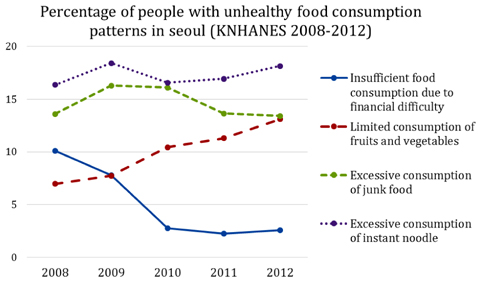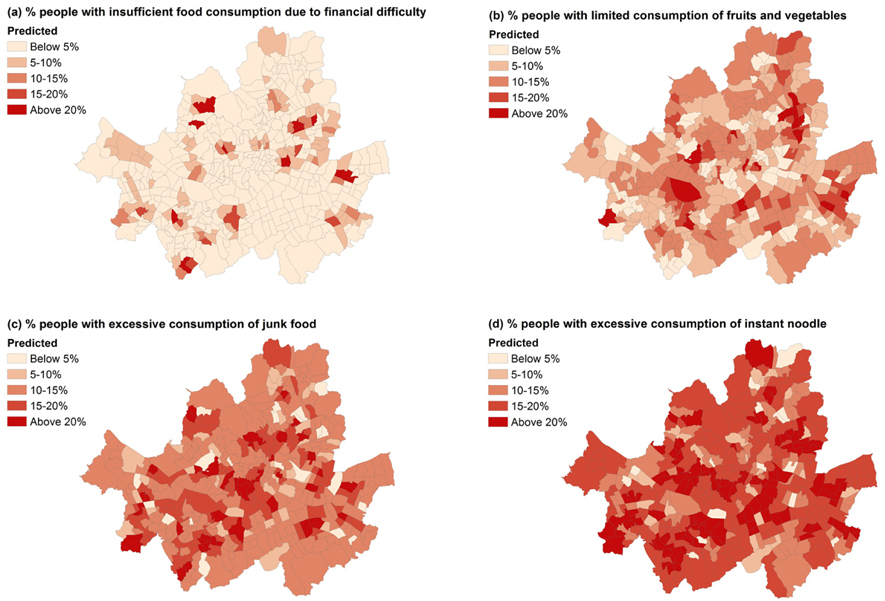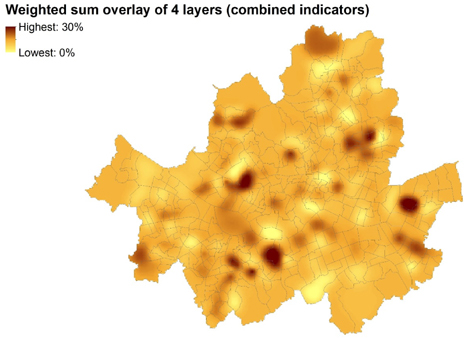Nutr Res Pract.
2016 Oct;10(5):530-536. 10.4162/nrp.2016.10.5.530.
Food deserts in Korea? A GIS analysis of food consumption patterns at sub-district level in Seoul using the KNHANES 2008-2012 data
- Affiliations
-
- 1School of Economic, Political and Policy Sciences, The University of Texas at Dallas, Richardson, TX 75080-3021, United States.
- 2Department of Urban Policy and Administration, Incheon National University, 119 Academy-ro, Yeonsu-gu, Incheon 22012, Korea. changkillee@incheon.ac.kr
- 3Division of Architecture and Urban Planning, Incheon National University, Incheon 22012, Korea.
- KMID: 2434088
- DOI: http://doi.org/10.4162/nrp.2016.10.5.530
Abstract
- BACKGROUND/OBJECTIVES
The concept of "food deserts" has been widely used in Western countries as a framework to identify areas with constrained access to fresh and nutritious foods, providing guidelines for targeted nutrition and public health programs. Unlike the vast amount of literature on food deserts in a Western context, only a few studies have addressed the concept in an East Asian context, and none of them have investigated spatial patterns of unhealthy food consumption from a South Korean perspective.
SUBJECTS/METHODS
We first evaluated the applicability of food deserts in a Korean setting and identified four Korean-specific unhealthy food consumption indicators, including insufficient food consumption due to financial difficulty, limited consumption of fruits and vegetables, excessive consumption of junk food, and excessive consumption of instant noodles. The KNHANES 2008-2012 data in Seoul were analyzed with stratified sampling weights to understand the trends and basic characteristics of these eating patterns in each category. GIS analyses were then conducted for the data spatially aggregated at the sub-district level in order to create maps identifying areas of concern regarding each of these indicators and their combinations.
RESULTS
Despite significant reduction in the rate of food insufficiency due to financial difficulty, the rates of excessive consumption of unhealthy foods (junk food and instant noodles) as well as limited consumption of fruits and vegetables have increased or remained high. These patterns tend to be found among relatively younger and more educated groups, regardless of income status.
CONCLUSIONS
A GIS-based analysis demonstrated several hotspots as potential "food deserts" tailored to the Korean context based on the observed spatial patterns of undesirable food consumption. These findings could be used as a guide to prioritize areas for targeted intervention programs to facilitate healthy food consumption behaviors and thus improve nutrition and food-related health outcomes.
Keyword
MeSH Terms
Figure
Reference
-
1. Cummins S, Macintyre S. The location of food stores in urban areas: a case study in Glasgow. Br Food J. 1999; 101:545–553.
Article2. Walker RE, Keane CR, Burke JG. Disparities and access to healthy food in the United States: a review of food deserts literature. Health Place. 2010; 16:876–884.
Article3. Furey S, Strugnell C, McIlveen MH. An investigation of the potential existence of "food deserts" in rural and urban areas of Northern Ireland. Agric Human Values. 2001; 18:447–457.4. Kim K, Kim MK, Shin YJ. The concept and measurement of food security. J Prev Med Public Health. 2008; 41:387–396.
Article5. Moore LV, Diez Roux AV. Associations of neighborhood characteristics with the location and type of food stores. Am J Public Health. 2006; 96:325–331.
Article6. Galvez MP, Morland K, Raines C, Kobil J, Siskind J, Godbold J, Brenner B. Race and food store availability in an inner-city neighbourhood. Public Health Nutr. 2008; 11:624–631.
Article7. Gordon C, Purciel-Hill M, Ghai NR, Kaufman L, Graham R, Van Wye G. Measuring food deserts in New York City's low-income neighborhoods. Health Place. 2011; 17:696–700.
Article8. Carolan MS. Reclaiming Food Security. Abingdon: Routledge;2013.9. Schafft KA, Jensen EB, Hinrichs CC. Food deserts and overweight schoolchildren: evidence from Pennsylvania. Rural Sociol. 2009; 74:153–177.
Article10. Jennings A, Cassidy A, Winters T, Barnes S, Lipp A, Holland R, Welch A. Positive effect of a targeted intervention to improve access and availability of fruit and vegetables in an area of deprivation. Health Place. 2012; 18:1074–1078.
Article11. Hanibuchi T, Kondo K, Nakaya T, Nakade M, Ojima T, Hirai H, Kawachi I. Neighborhood food environment and body mass index among Japanese older adults: results from the Aichi Gerontological Evaluation Study (AGES). Int J Health Geogr. 2011; 10:43.
Article12. Iwama N, Tanaka K, Sasaki M, Komaki N, Saito Y. The dietary life of the elderly in local cities and food desert issues: a case study of Mito city, Ibaraki prefecture. Jpn J Hum Geogr. 2009; 61:139–156.
Article13. Choi Y, Suzuki T. Food deserts, activity patterns, & social exclusion: the case of Tokyo, Japan. Appl Geogr. 2013; 43:87–98.
Article14. Murakami K, Sasaki S, Takahashi Y, Uenishi K. Japan Dietetic Students' Study for Nutrition and Biomarkers Group. Neighborhood food store availability in relation to food intake in young Japanese women. Nutrition. 2009; 25:640–646.
Article15. Pearson T, Russell J, Campbell MJ, Barker ME. Do 'food deserts' influence fruit and vegetable consumption?--A cross-sectional study. Appetite. 2005; 45:195–197.
Article16. Moon S. A study on determining the extent of damage and decreasing rate of supermarket sales by new SSM store. In : The 2010 Fall Conference of KREAA; Seoul: Korea Real Estate Analysts Association;2010. p. 355–375.17. Park EY, Han SN, Kim HK. Assessment of meal quality and dietary behaviors of children in low-income families by diet records and interviews. Korean J Food Nutr. 2011; 24:145–152.
Article18. Hwang JY, Ru SY, Ryu HK, Park HJ, Kim WY. Socioeconomic factors relating to obesity and inadequate nutrient intake in women in low income families residing in Seoul. Korean J Nutr. 2009; 42:171–182.
Article19. Nam KH, Kim YM, Lee GE, Lee YN, Joung H. Physical development and dietary behaviors of children in low-income families of Seoul area. Korean J Community Nutr. 2006; 11:172–179.20. Jang HB, Park JY, Lee HJ, Kang JH, Park KH, Song J. Association between parental socioeconomic level, overweight, and eating habits with diet quality in Korean sixth grade school children. Korean J Nutr. 2011; 44:416–427.
Article21. Chun IA, Ryu SY, Park J, Ro HK, Han MA. Associations between food insecurity and healthy behaviors among Korean adults. Nutr Res Pract. 2015; 9:425–432.
Article22. Kim HJ, Oh K. Household food insecurity and dietary intake in Korea: results from the 2012 Korea National Health and Nutrition Examination Survey. Public Health Nutr. 2015; 18:3317–3325.
Article23. Kim HJ, Lee HJ. Food security in Korea and its policy agendas. Health Soc Welf Rev. 2012; 32:468–499.
Article24. Kim S, Moon S, Popkin BM. The nutrition transition in South Korea. Am J Clin Nutr. 2000; 71:44–53.
Article25. Kwon YS, Ju SY. Trends in nutrient intakes and consumption while eating-out among Korean adults based on Korea National Health and Nutrition Examination Survey (1998-2012) data. Nutr Res Pract. 2014; 8:670–678.
Article26. Kim Y, Kwon YS, Park YH, Choe JS, Lee JY. Analysis of consumption frequencies of vegetables and fruits in Korean adolescents based on Korea youth risk behavior web-based survey (2006, 2011). Nutr Res Pract. 2015; 9:411–419.
Article27. Heo GJ, Nam SY, Lee SK, Chung SJ, Yoon JH. The relationship between high energy/low nutrient food consumption and obesity among Korean children and adolescents. Korean J Community Nutr. 2012; 17:226–242.
Article28. Park S, Choi BY, Wang Y, Colantuoni E, Gittelsohn J. School and neighborhood nutrition environment and their association with students' nutrition behaviors and weight status in Seoul, South Korea. J Adolesc Health. 2013; 53:655–662.e12.
Article29. Shin HJ, Cho E, Lee HJ, Fung TT, Rimm E, Rosner B, Manson JE, Wheelan K, Hu FB. Instant noodle intake and dietary patterns are associated with distinct cardiometabolic risk factors in Korea. J Nutr. 2014; 144:1247–1255.
Article30. Lee SY, Ha SA, Seo JS, Sohn CM, Park HR, Kim KW. Eating habits and eating behaviors by family dinner frequency in the lower-grade elementary school students. Nutr Res Pract. 2014; 8:679–687.
Article31. Seo HS, Lee SK, Nam S. Factors influencing fast food consumption behaviors of middle-school students in Seoul: an application of theory of planned behaviors. Nutr Res Pract. 2011; 5:169–178.
Article32. Lee JS, Kim J. Vegetable intake in Korea: data from the Korean National Health and Nutrition Examination Survey 1998, 2001 and 2005. Br J Nutr. 2010; 103:1499–1506.
Article33. Park J, Lee JS, Jang YA, Chung HR, Kim J. A comparison of food and nutrient intake between instant noodle consumers and non-instant noodle consumers in Korean adults. Nutr Res Pract. 2011; 5:443–449.
Article34. Seo S, Kim D, Min S, Paul C, Yoo Y, Choung JT. GIS-based association between PM10 and allergic diseases in Seoul: implications for health and environmental policy. Allergy Asthma Immunol Res. 2016; 8:32–40.
Article35. Kweon S, Kim Y, Jang MJ, Kim Y, Kim K, Choi S, Chun C, Khang YH, Oh K. Data resource profile: the Korea National Health and Nutrition Examination Survey (KNHANES). Int J Epidemiol. 2014; 43:69–77.
Article36. Goodchild MF, Anselin L, Deichmann U. A framework for the areal interpolation of socioeconomic data. Environ Plan A. 1993; 25:383–397.
Article37. Carver SJ. Integrating multi-criteria evaluation with geographical information systems. Int J Geogr Inf Syst. 1991; 5:321–339.
Article38. Lytle LA. Measuring the food environment: state of the science. Am J Prev Med. 2009; 36:S134–S144.39. Story M, Kaphingst KM, Robinson-O'Brien R, Glanz K. Creating healthy food and eating environments: policy and environmental approaches. Annu Rev Public Health. 2008; 29:253–272.
Article40. Austin SB, Melly SJ, Sanchez BN, Patel A, Buka S, Gortmaker SL. Clustering of fast-food restaurants around schools: a novel application of spatial statistics to the study of food environments. Am J Public Health. 2005; 95:1575–1581.
Article41. Yeom HA, Jung D, Choi M. Adherence to physical activity among older adults using a geographical information system: Korean National Health and Nutrition Examinations Survey IV. Asian Nurs Res (Korean Soc Nurs Sci). 2011; 5:118–127.
Article42. Rose D, Bodor JN, Swalm CM, Rice JC, Farley TA, Hutchinson PL. Deserts in New Orleans? Illustrations of Urban Food Access and Implications for Policy. Ann Arbor (MI): University of Michigan National Poverty Center/USDA Economic Research Service Research;2009.
- Full Text Links
- Actions
-
Cited
- CITED
-
- Close
- Share
- Similar articles
-
- The Relationship between High Energy/Low Nutrient Food Consumption and Obesity among Korean Children and Adolescents
- Analysis of Food Consumption Patterns by Income Levels Using Annual Report on the Family Income and Expenditure Survey
- Time Series Analysis of Food Consumption Away from Home for Urban Household in Korea : 1982 - 2002
- Estimation of the Usual Food Intake Distribution Reflecting the Consumption Frequency and a Comparison of the Proportion of Non-consumers: Based on the KNHANES 2009
- Analysis of the Difference in Nutrients Intake, Dietary Behaviors and Food Intake Frequency of Single- and Non Single-Person Households: The Korea National Health and Nutrition Examination Survey (KNHANES), 2014–2016




